I found a larger data set and wanted to show how you could use the Kaplan Meier curves as a preliminary screen of some categorical and continuous variables in a larger and more complex data set.
I am building on a previous blog entry and this referred to an earlier webpage. Here is the R code. The comment section at the top is a cut-and-paste from the documentation of the data file.
# Some simple examples of survival analysis
# The data set is a study of primary biliary cirrhosis
# Variables:
# V1 case number
# V2 number of days between registration and the earlier of death,
# transplantion
- or study analysis time in July
- 1986
V3 status
0=censored
- 1=censored due to liver tx
- 2=death
V4 drug
1= D-penicillamine
- 2=placebo
V5 age in days
V6 sex
0=male
- 1=female
V7 presence of asictes
0=no 1=yes
V8 presence of hepatomegaly
0=no 1=yes
V9 presence of spiders
0=no 1=yes
V10 presence of edema
0 = no edema and no diuretic therapy for edema;
0.5 = edema present without diuretics
- or edema resolved by diuretics;
1 = edema despite diuretic therapy
V11 serum bilirubin in mg/dl
V12 serum cholesterol in mg/dl
V13 albumin in gm/dl
V14 urine copper in ug/day#
V15 alkaline phosphatase in U/liter
V16 SGOT in U/ml
V17 triglicerides in mg/dl
V18 platelets per cubic ml / 1000
V19 prothrombin time in seconds
V20 histologic stage of disease
Read the data in from the website. The first 60 rows are documentation about the file and the actual data starts on line 61.
fn <- "http://lib.stat.cmu.edu/datasets/pbc"
pbc <- read.table(fn,header=FALSE,skip=60)
head(pbc)
V1 V2 V3 V4 V5 V6 V7 V8 V9 V10 V11 V12 V13 V14 V15 V16 V17 V18 V19 V20
1 1 400 2 1 21464 1 1 1 1 1.0 14.5 261 2.60 156 1718.0 137.95 172 190 12.2 4
2 2 4500 0 1 20617 1 0 1 1 0.0 1.1 302 4.14 54 7394.8 113.52 88 221 10.6 3
3 3 1012 2 1 25594 0 0 0 0 0.5 1.4 176 3.48 210 516.0 96.10 55 151 12.0 4
4 4 1925 2 1 19994 1 0 1 1 0.5 1.8 244 2.54 64 6121.8 60.63 92 183 10.3 4
5 5 1504 1 2 13918 1 0 1 1 0.0 3.4 279 3.53 143 671.0 113.15 72 136 10.9 3
6 6 2503 2 2 24201 1 0 1 0 0.0 0.8 248 3.98 50 944.0 93.00 63 . 11.0 3
The data looks like it read in properly
-
so let’s load the survival library.
library(“survival”) Loading required package: splines
Attaching package: <U+0091>survival<U+0092>
The following object is masked by <U+0091>.GlobalEnv<U+0092>:
pbc
Now that’s strange. There is an object in the survival library that has the same name (pbc). Let’s investigate.
> rm(pbc)
> head(pbc)
id time status trt age sex ascites hepato spiders edema bili chol albumin copper alk.phos
1 1 400 2 1 58.76523 f 1 1 1 1.0 14.5 261 2.60 156 1718.0
2 2 4500 0 1 56.44627 f 0 1 1 0.0 1.1 302 4.14 54 7394.8
3 3 1012 2 1 70.07255 m 0 0 0 0.5 1.4 176 3.48 210 516.0
4 4 1925 2 1 54.74059 f 0 1 1 0.5 1.8 244 2.54 64 6121.8
5 5 1504 1 2 38.10541 f 0 1 1 0.0 3.4 279 3.53 143 671.0
6 6 2503 2 2 66.25873 f 0 1 0 0.0 0.8 248 3.98 50 944.0
ast trig platelet protime stage
1 137.95 172 190 12.2 4
2 113.52 88 221 10.6 3
3 96.10 55 151 12.0 4
4 60.63 92 183 10.3 4
5 113.15 72 136 10.9 3
6 93.00 63 NA 11.0 3
Wow! The data set I was importing was already part of the survival library. Let’s use their version
- since it has better names for the variables than V1-V20.
We have to subset the data because the first 312 observations represent a randomized trial and the remaining observations are an add-on study of baseline values for some non-randomized patients.
> tail(pbc)
id time status trt age sex ascites hepato spiders edema bili chol albumin copper
413 413 989 0 NA 35.00068 f NA NA NA 0 0.7 NA 3.23 NA
414 414 681 2 NA 67.00068 f NA NA NA 0 1.2 NA 2.96 NA
415 415 1103 0 NA 39.00068 f NA NA NA 0 0.9 NA 3.83 NA
416 416 1055 0 NA 56.99932 f NA NA NA 0 1.6 NA 3.42 NA
417 417 691 0 NA 58.00137 f NA NA NA 0 0.8 NA 3.75 NA
418 418 976 0 NA 52.99932 f NA NA NA 0 0.7 NA 3.29 NA
alk.phos ast trig platelet protime stage
413 NA NA NA 312 10.8 3
414 NA NA NA 174 10.9 3
415 NA NA NA 180 11.2 4
416 NA NA NA 143 9.9 3
417 NA NA NA 269 10.4 3
418 NA NA NA 350 10.6 4
> pmod <- pbc[1:312,]
> tail(pmod)
id time status trt age sex ascites hepato spiders edema bili chol albumin copper
307 307 1149 0 2 30.57358 f 0 0 0 0 0.8 273 3.56 52
308 308 1153 0 1 61.18275 f 0 1 0 0 0.4 246 3.58 24
309 309 994 0 2 58.29979 f 0 0 0 0 0.4 260 2.75 41
310 310 939 0 1 62.33265 f 0 0 0 0 1.7 434 3.35 39
311 311 839 0 1 37.99863 f 0 0 0 0 2.0 247 3.16 69
312 312 788 0 2 33.15264 f 0 0 1 0 6.4 576 3.79 186
alk.phos ast trig platelet protime stage
307 1282 130 59 344 10.5 2
308 797 91 113 288 10.4 2
309 1166 70 82 231 10.8 2
310 1713 171 100 234 10.2 2
311 1050 117 88 335 10.5 2
312 2115 136 149 200 10.8 2
Take a look at the two key variables needed to define the survival object. Dividing by 365.25 gives the times in years rather than in days.
> summary(pmodtime)
Min. 1st Qu. Median Mean 3rd Qu. Max.
41 1191 1840 2006 2697 4556
> summary(pmodtime/365.25)
Min. 1st Qu. Median Mean 3rd Qu. Max.
0.1123 3.2610 5.0360 5.4930 7.3850 12.4700
> table(pmodstatus)
0 1 2
168 19 125
The values for status
-
if you read the documentation
-
are 0=censored, 1=transplant
-
and 2=death. You could define an event as either 1 and 2 or 2 by itself. Choose the latter for this example.
p.surv >- Surv(pmodtime,pmod$status==2) print(p.surv) [1] 400 4500+ 1012 1925 1504+ 2503 1832+ 2466 2400 51 3762 304 3577+ 1217 3584 [16] 3672+ 769 131 4232+ 1356 3445+ 673 264 4079 4127+ 1444 77 549 4509+ 321 [31] 3839 4523+ 3170 3933+ 2847 3611+ 223 3244 2297 4467+ 1350 4453+ 4556+ 3428 4025+ [46] 2256 2576+ 4427+ 708 2598 3853 2386 1000 1434 1360 1847 3282 4459+ 2224 4365+ [61] 4256+ 3090 859 1487 3992+ 4191 2769 4039+ 1170 3458+ 4196+ 4184+ 4190+ 1827 1191 [76] 71 326 1690 3707+ 890 2540 3574 4050+ 4032+ 3358 1657 198 2452+ 1741 2689 [91] 460 388 3913+ 750 130 3850+ 611 3823+ 3820+ 552 3581+ 3099+ 110 3086 3092+ [106] 3222 3388+ 2583 2504+ 2105 2350+ 3445 980 3395 3422+ 3336+ 1083 2288 515 2033+ [121] 191 3297+ 971 3069+ 2468+ 824 3255+ 1037 3239+ 1413 850 2944+ 2796 3149+ 3150+ [136] 3098+ 2990+ 1297 2106+ 3059+ 3050+ 2419 786 943 2976+ 2615+ 2995+ 1427 762 2891+ [151] 2870+ 1152 2863+ 140 2666+ 853 2835+ 2475+ 1536 2772+ 2797+ 186 2055 264 1077 [166] 2721+ 1682 2713+ 1212 2692+ 2574+ 2301+ 2657+ 2644+ 2624+ 1492 2609+ 2580+ 2573+ 2563+ [181] 2556+ 2555+ 2241+ 974 2527+ 1576 733 2332+ 2456+ 2504+ 216 2443+ 797 2449+ 2330+ [196] 2363+ 2365+ 2357+ 1592+ 2318+ 2294+ 2272+ 2221+ 2090 2081 2255+ 2171+ 904 2216+ 2224+ [211] 2195+ 2176+ 2178+ 1786 1080 2168+ 790 2170+ 2157+ 1235 2050+ 597 334 1945+ 2022+ [226] 1978+ 999 1967+ 348 1979+ 1165 1951+ 1932+ 1776+ 1882+ 1908+ 1882+ 1874+ 694 1831+ [241] 837+ 1810+ 930 1690 1790+ 1435+ 732+ 1785+ 1783+ 1769+ 1457+ 1770+ 1765+ 737+ 1735+ [256] 1701+ 1614+ 1702+ 1615+ 1656+ 1677+ 1666+ 1301+ 1542+ 1084+ 1614+ 179 1191 1363+ 1568+ [271] 1569+ 1525+ 1558+ 1447+ 1349+ 1481+ 1434+ 1420+ 1433+ 1412+ 41 1455+ 1030+ 1418+ 1401+ [286] 1408+ 1234+ 1067+ 799 1363+ 901+ 1329+ 1320+ 1302+ 877+ 1321+ 533+ 1300+ 1293+ 207 [301] 1295+ 1271+ 1250+ 1230+ 1216+ 1216+ 1149+ 1153+ 994+ 939+ 839+ 788+
First
-
let’s look at an overall survival curve.
plot(survfit(p.surv~1))
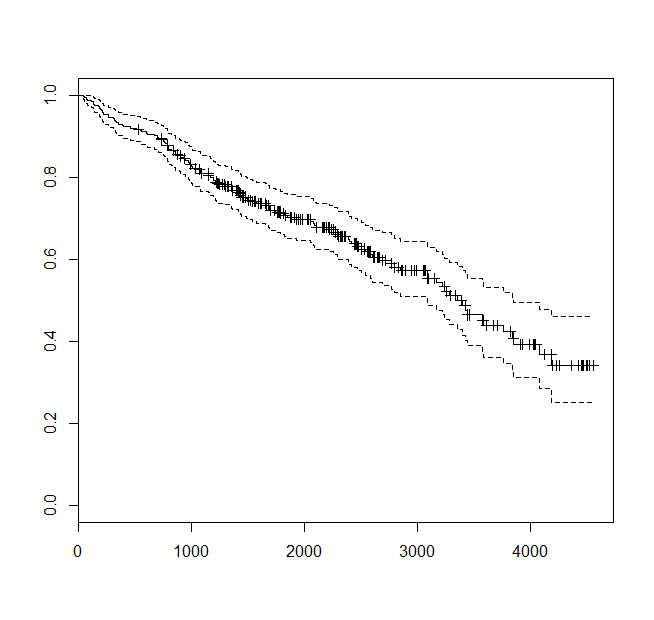
Now let’s define some functions that will calculate and compare Kaplan-Meier curves across all the possible covariates in the model. For categorical variables
-
draw Kaplan-Meier curves for each category level. For continuous variables
-
split the data into quartiles and then draw Kaplan-Meier curves for each quartile.
km.cat <- function(vn) { print(vn) print(table(pmod[,vn])) km.all(pmod[,vn]) title(vn) } km.con <- function(vn) { print(vn) br <- quantile(pmod[,vn],na.rm=TRUE) br[1] <- 0 quartiles <- cut(pmod[,vn],breaks=br) print(table(quartiles)) km.all(quartiles) title(vn) } km.all <- function(x) { tb <- table(x) mi <- sum(is.na(x)) sf <- survfit(p.surv~x) print(paste(“There are”,mi,“missing values.")) plot(sf,xlim=c(0,6000)) end.pts <- cumsum(sfstrata) end.x <- sftime[end.pts]+100 end.y <- sfsurv[end.pts] end.nm <- names(tb) text(end.x,end.y,end.nm,cex=1.5,col=“darkred”,adj=0) } v.cat <- names(pmod)[c(4,6:10,20)] v.con <- names(pmod)[c(5,11:19)] for (v in v.cat) { km.cat(v) } for (v in v.con) { km.con(v) }
Here is the output.
v.cat <- names(pmod)[c(4,6:10,20)]
v.con <- names(pmod)[c(5,11:19)]
for (v in v.cat) {
km.cat(v)
}
## [1] "trt"
##
## 1 2
## 158 154
## [1] "There are 0 missing values."
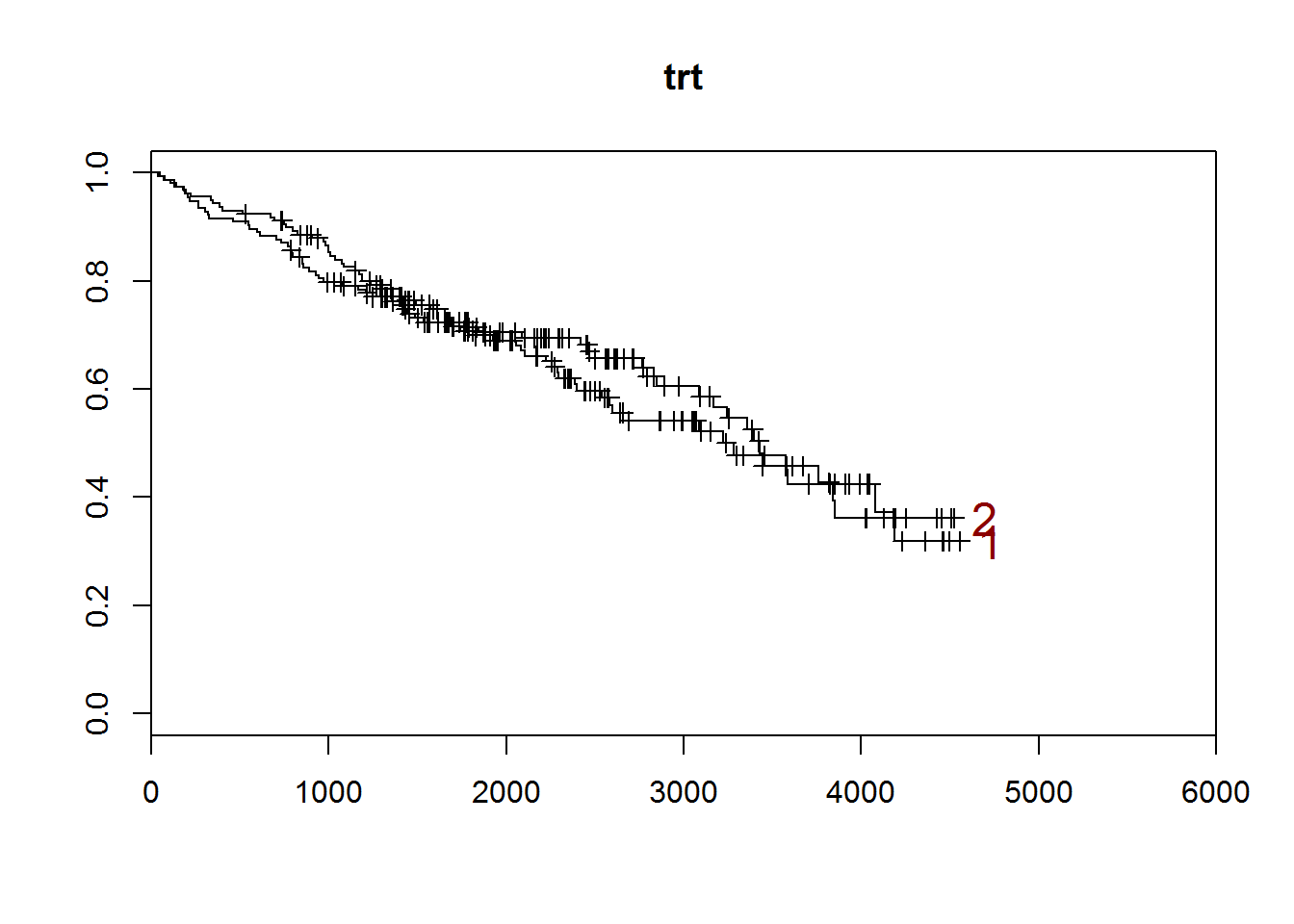
## [1] "sex"
##
## m f
## 36 276
## [1] "There are 0 missing values."
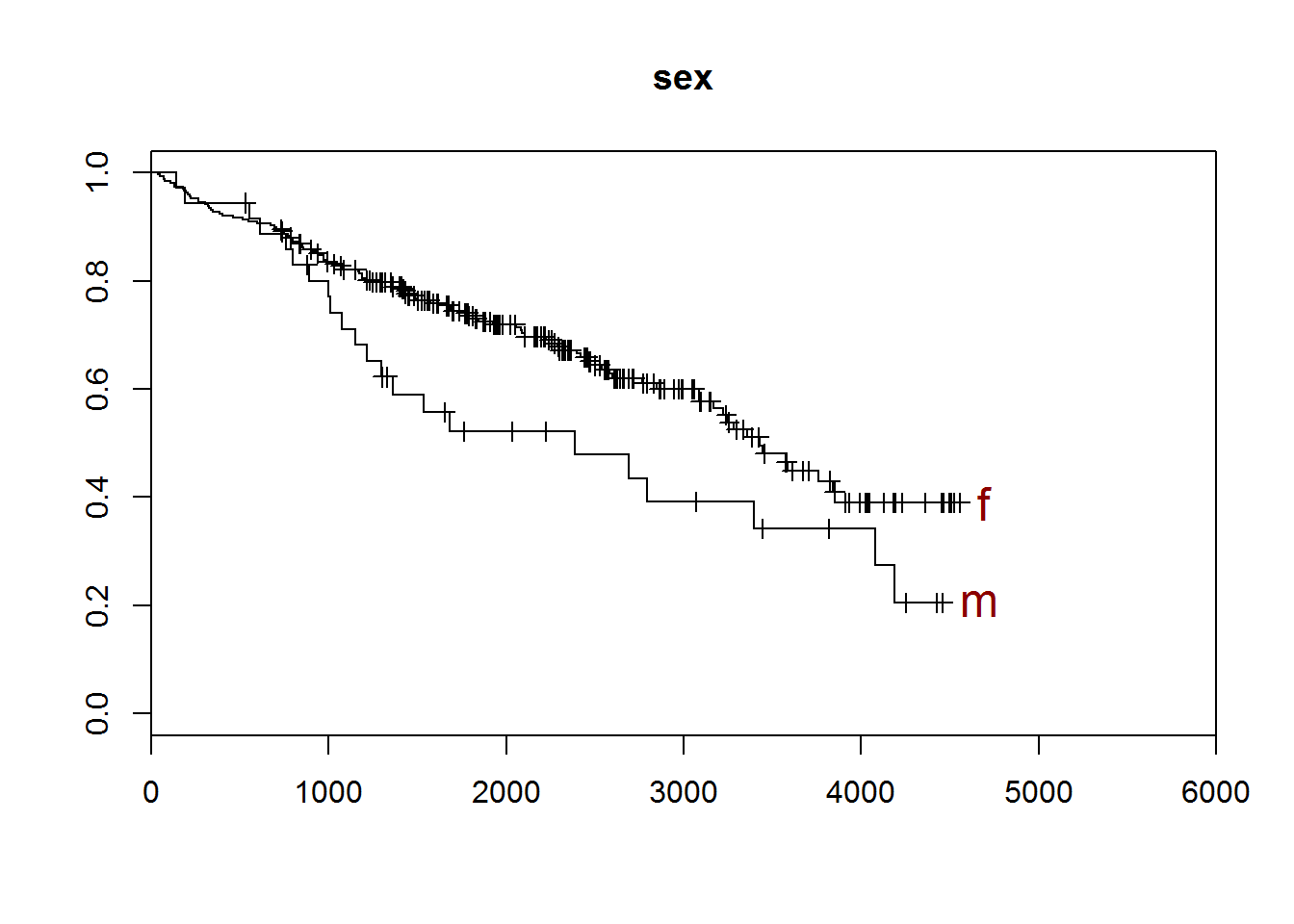
## [1] "ascites"
##
## 0 1
## 288 24
## [1] "There are 0 missing values."
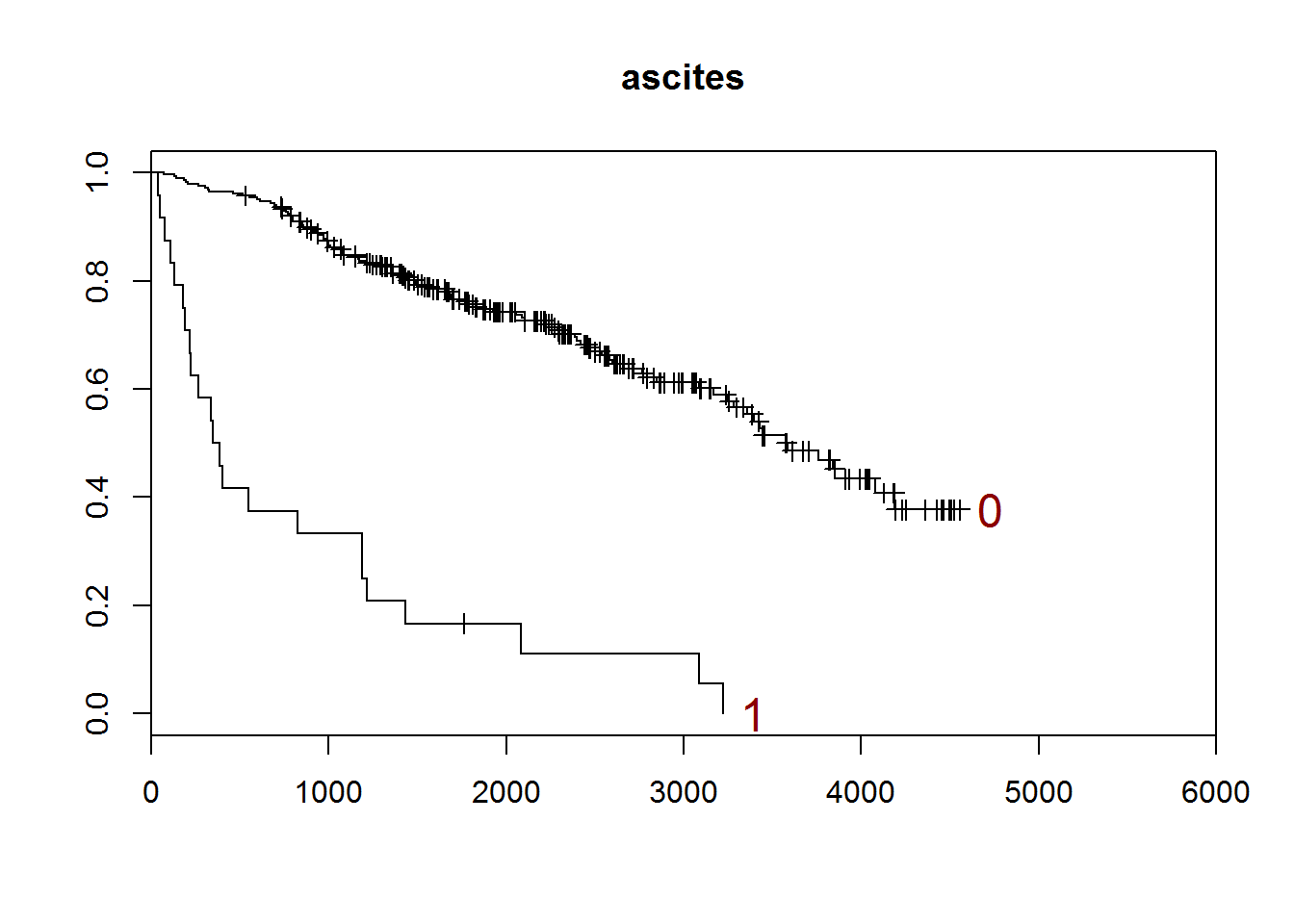
## [1] "hepato"
##
## 0 1
## 152 160
## [1] "There are 0 missing values."
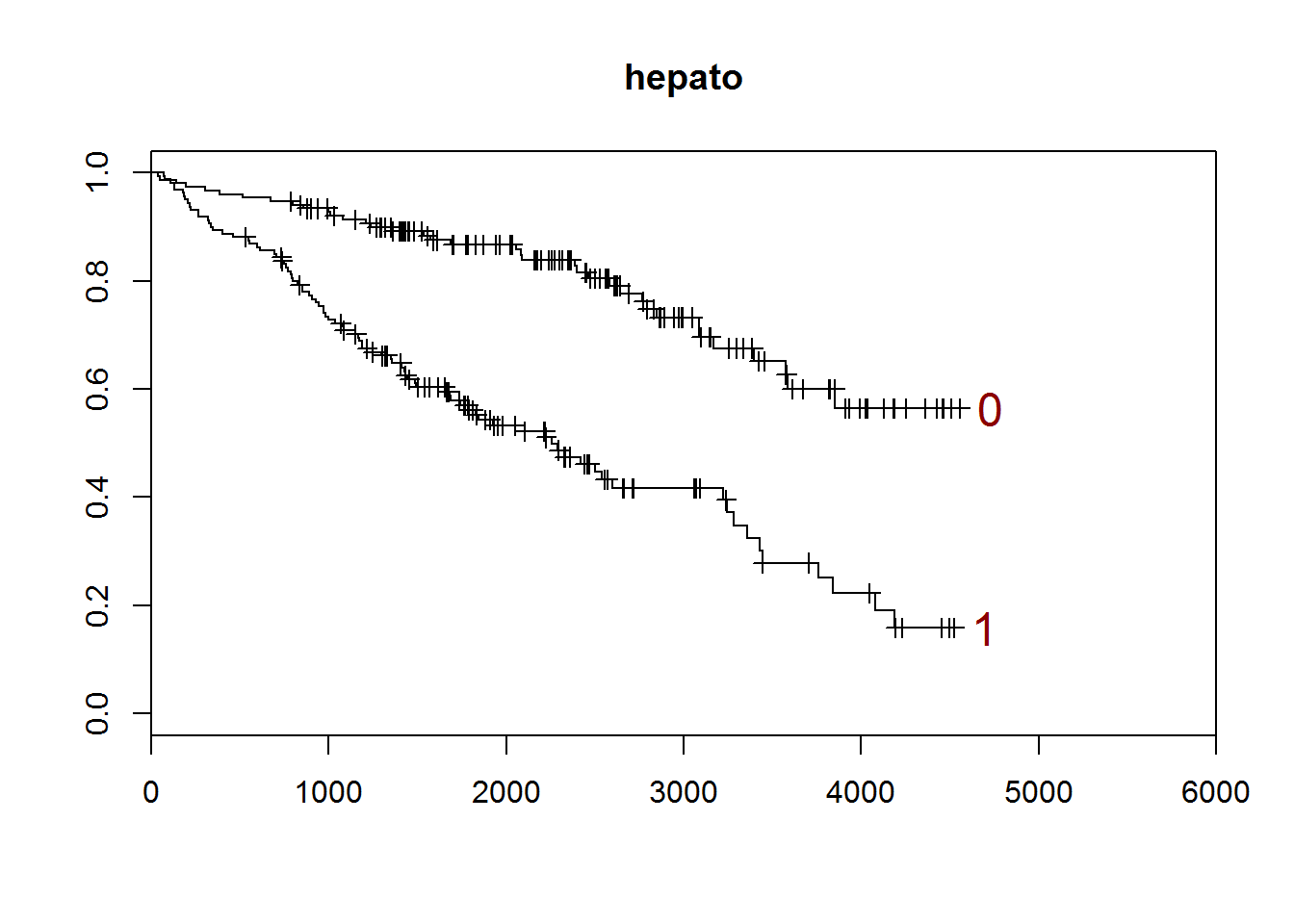
## [1] "spiders"
##
## 0 1
## 222 90
## [1] "There are 0 missing values."
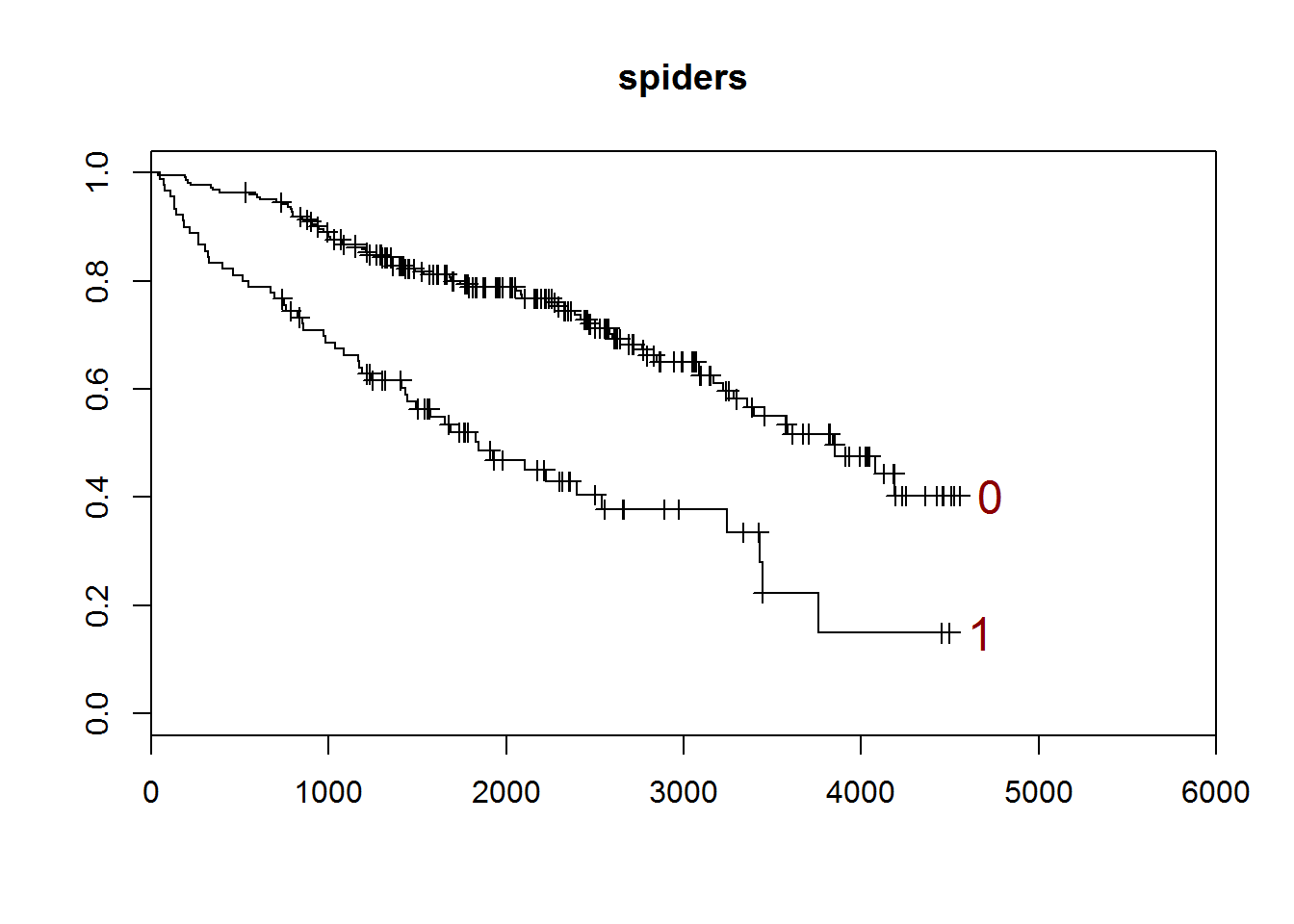
## [1] "edema"
##
## 0 0.5 1
## 263 29 20
## [1] "There are 0 missing values."
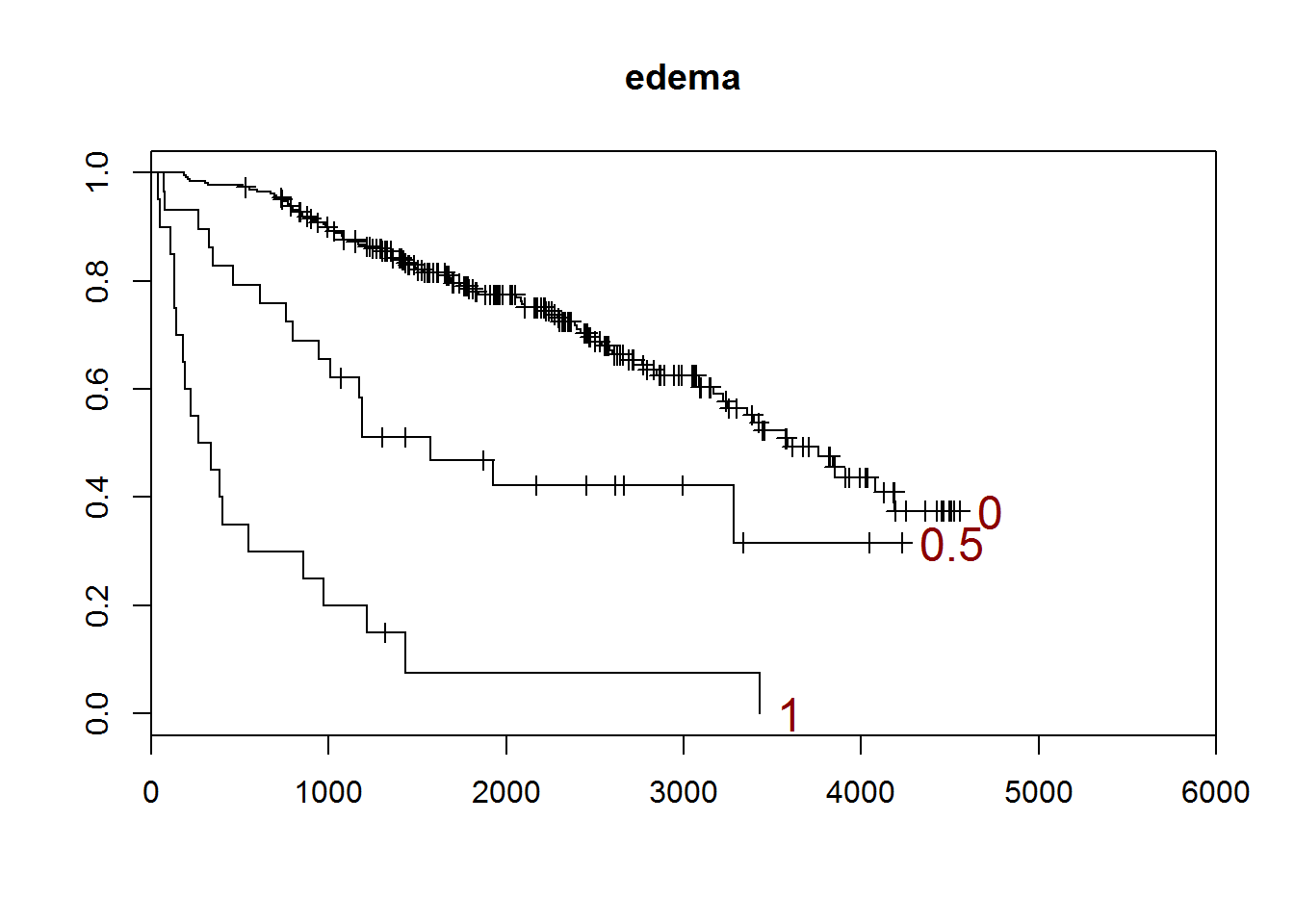
## [1] "stage"
##
## 1 2 3 4
## 16 67 120 109
## [1] "There are 0 missing values."
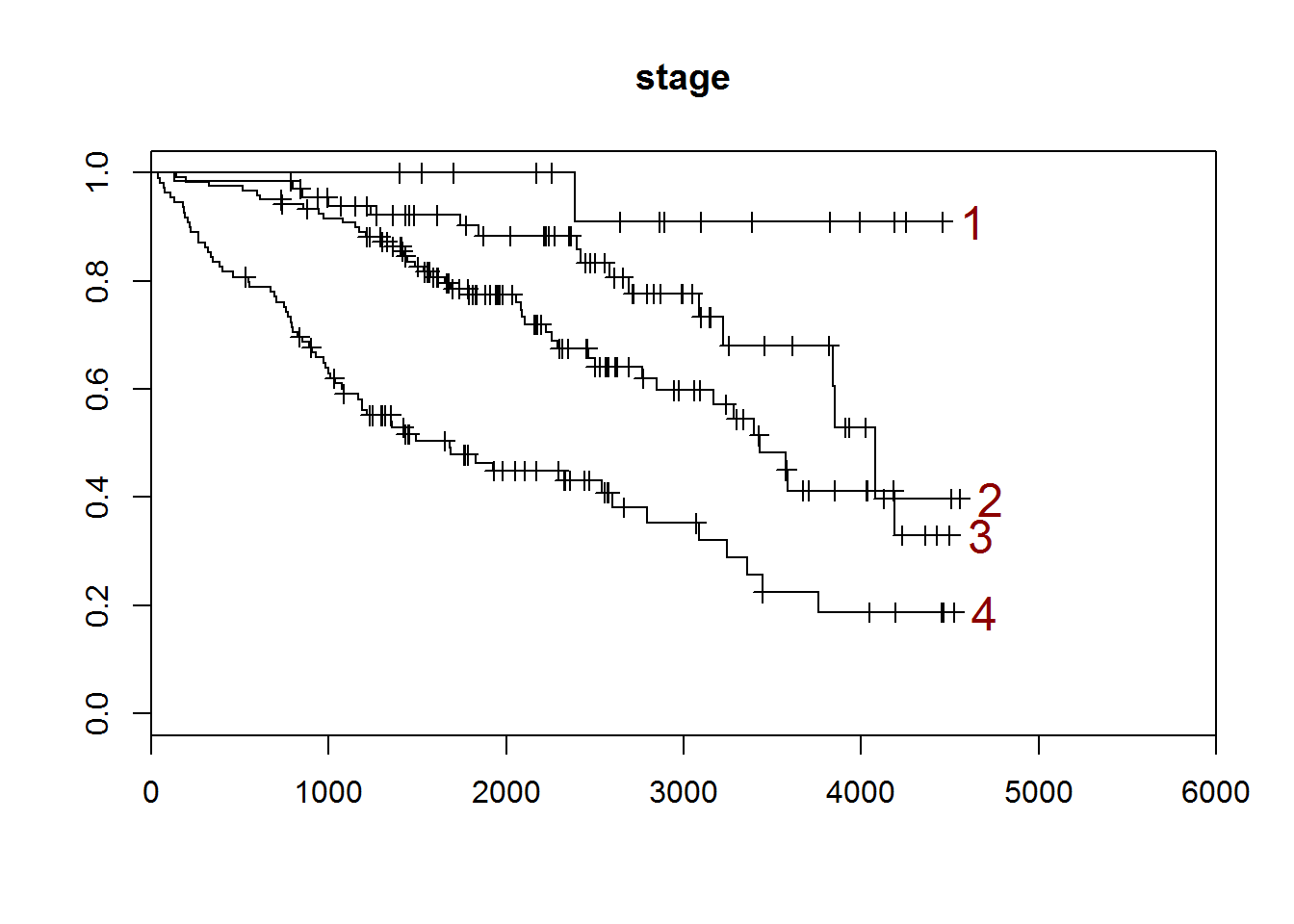
for (v in v.con) {
km.con(v)
}
## [1] "age"
## quartiles
## (0,42.2] (42.2,49.8] (49.8,56.7] (56.7,78.4]
## 78 78 78 78
## [1] "There are 0 missing values."
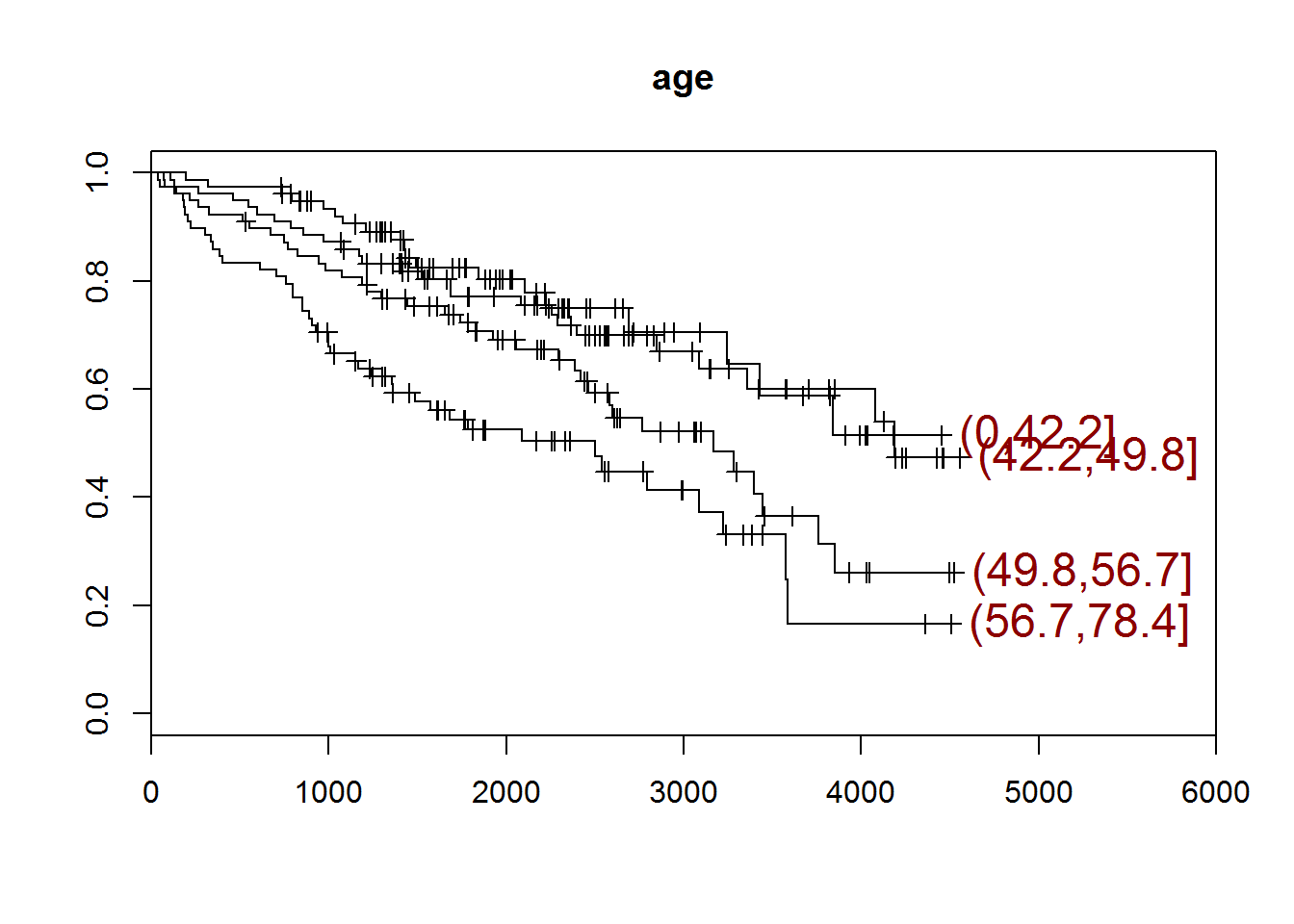
## [1] "bili"
## quartiles
## (0,0.8] (0.8,1.35] (1.35,3.42] (3.42,28]
## 90 66 78 78
## [1] "There are 0 missing values."
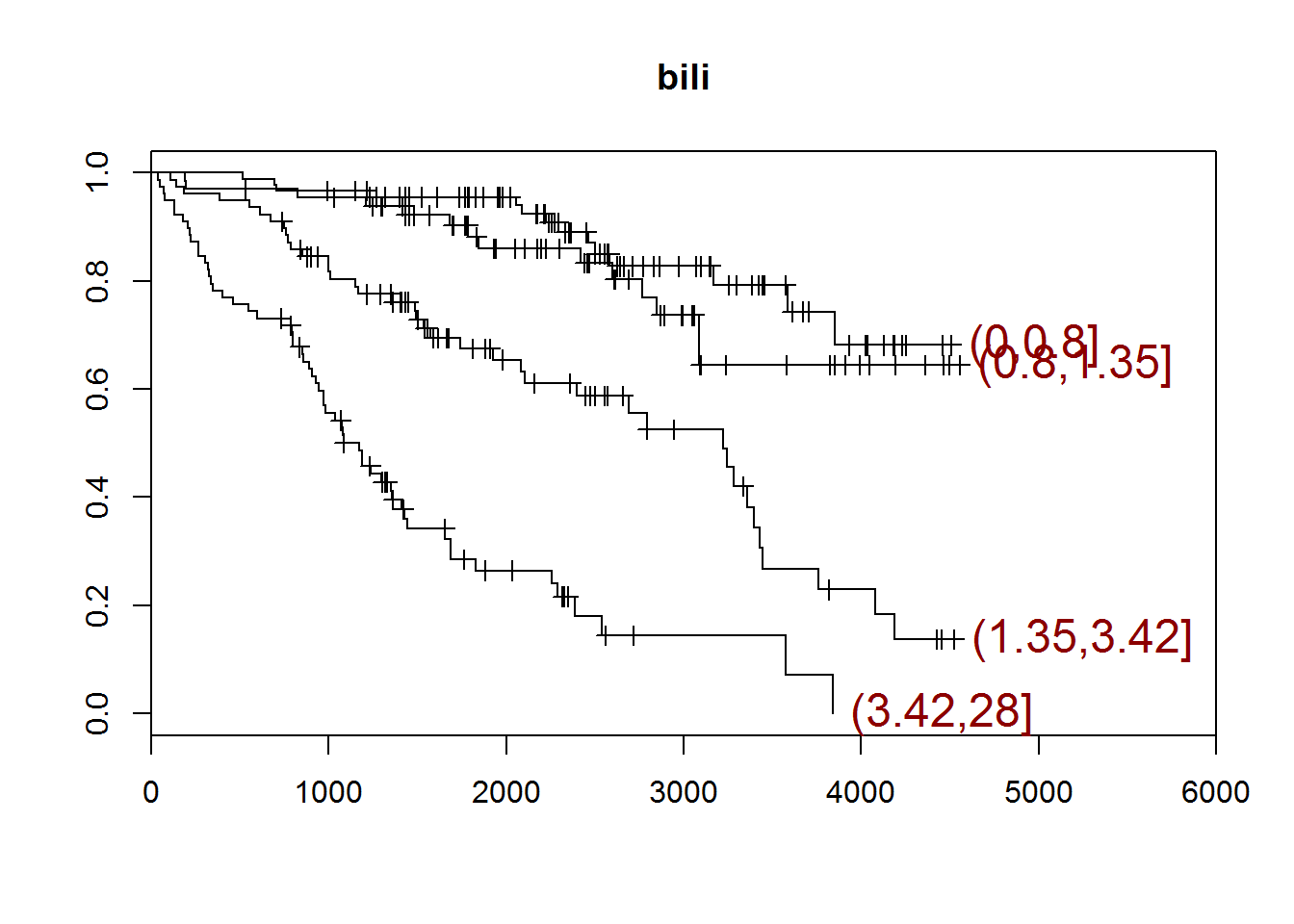
## [1] "chol"
## quartiles
## (0,250] (250,310] (310,400] (400,1.78e+03]
## 71 71 72 70
## [1] "There are 28 missing values."
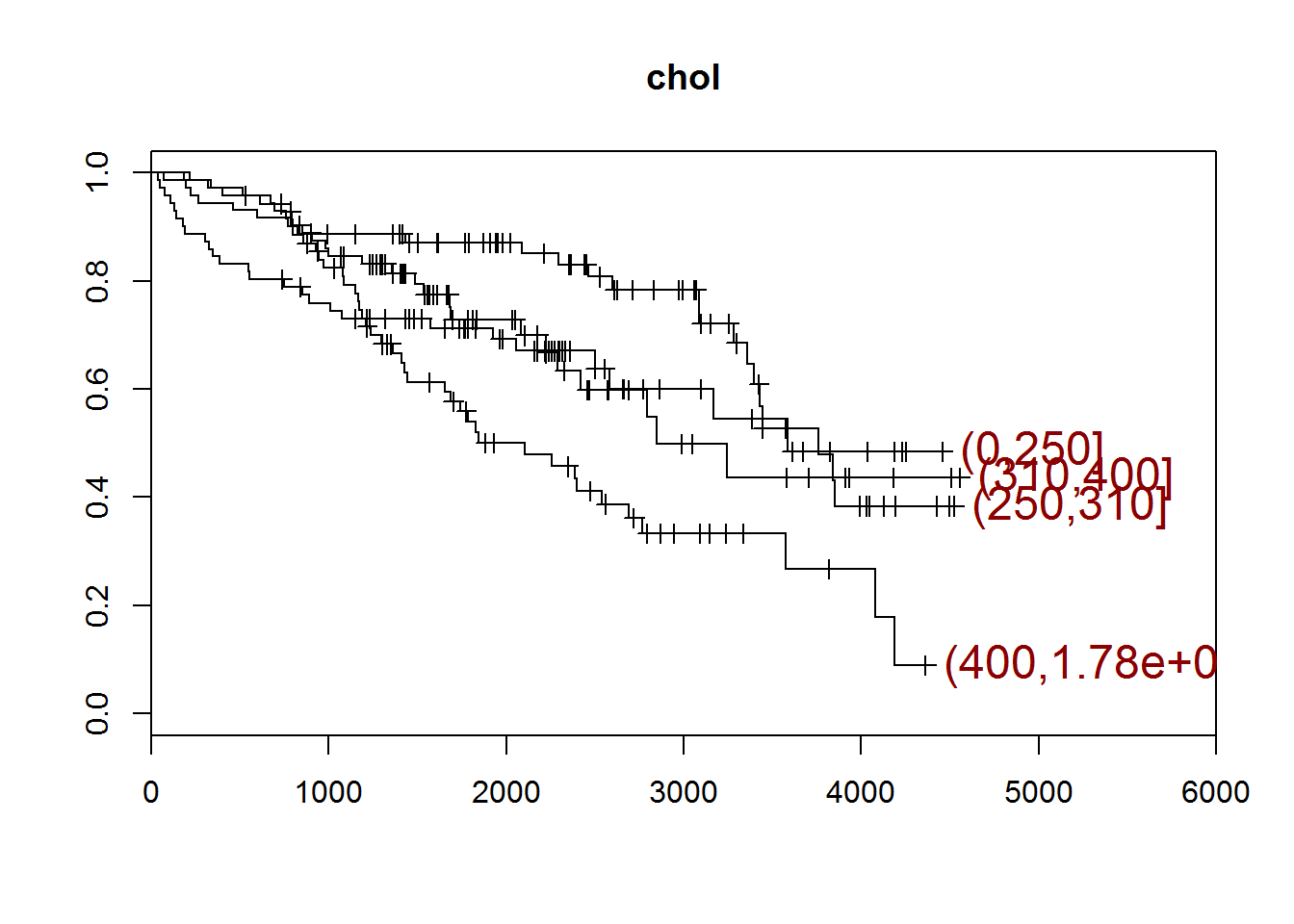
## [1] "albumin"
## quartiles
## (0,3.31] (3.31,3.55] (3.55,3.8] (3.8,4.64]
## 81 76 81 74
## [1] "There are 0 missing values."
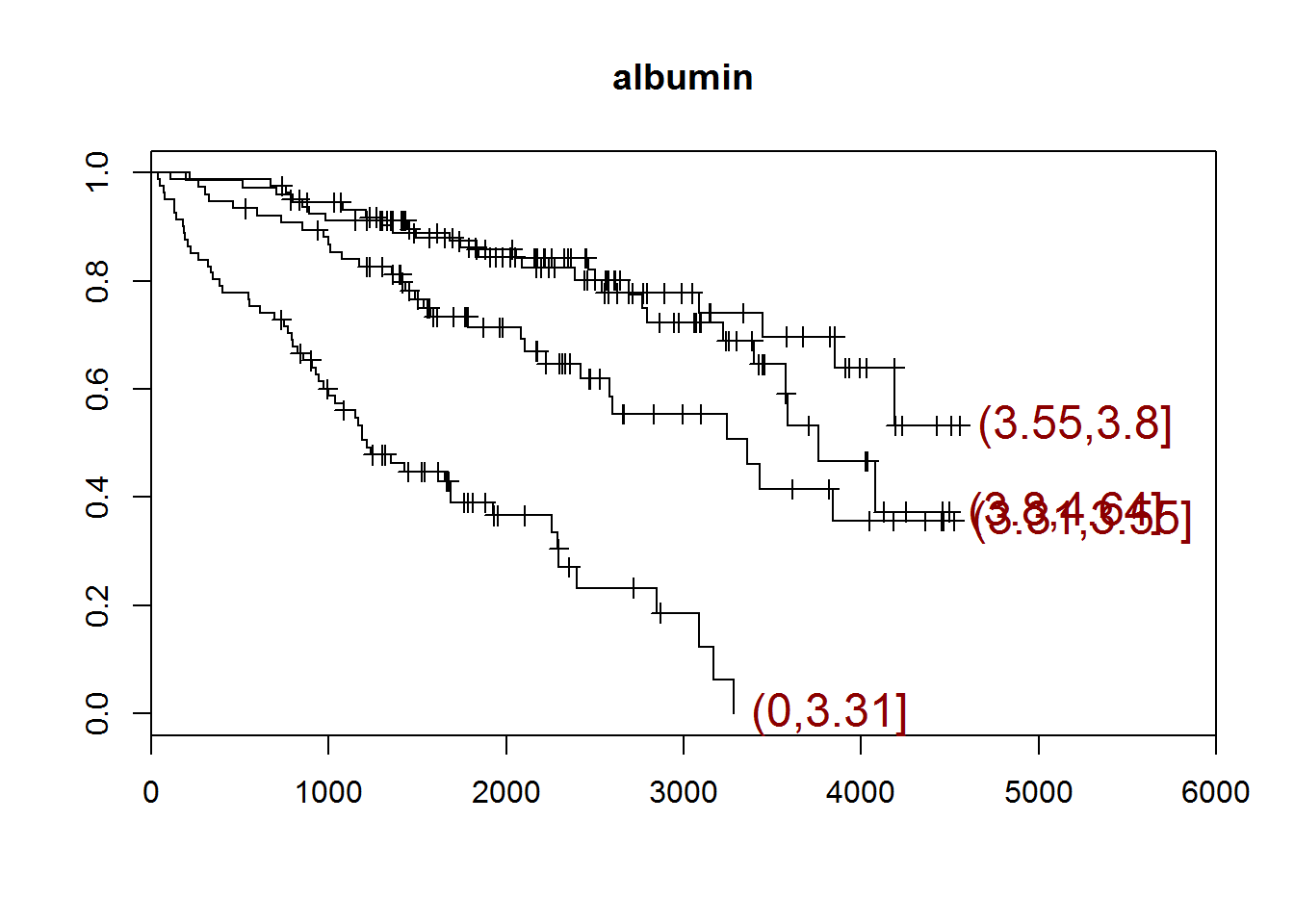
## [1] "copper"
## quartiles
## (0,41.2] (41.2,73] (73,123] (123,588]
## 78 80 75 77
## [1] "There are 2 missing values."
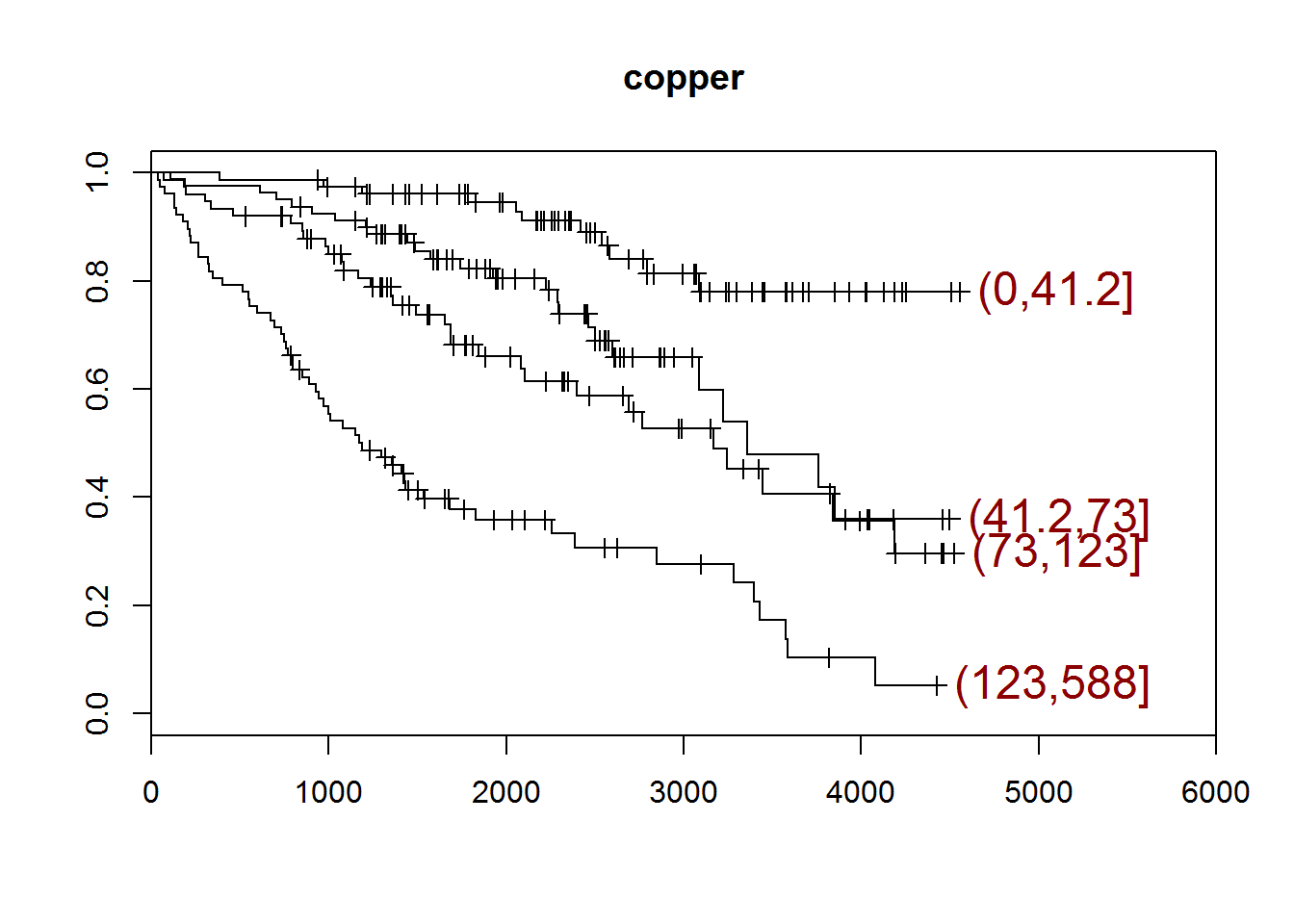
## [1] "alk.phos"
## quartiles
## (0,872] (872,1.26e+03] (1.26e+03,1.98e+03]
## 78 78 78
## (1.98e+03,1.39e+04]
## 78
## [1] "There are 0 missing values."
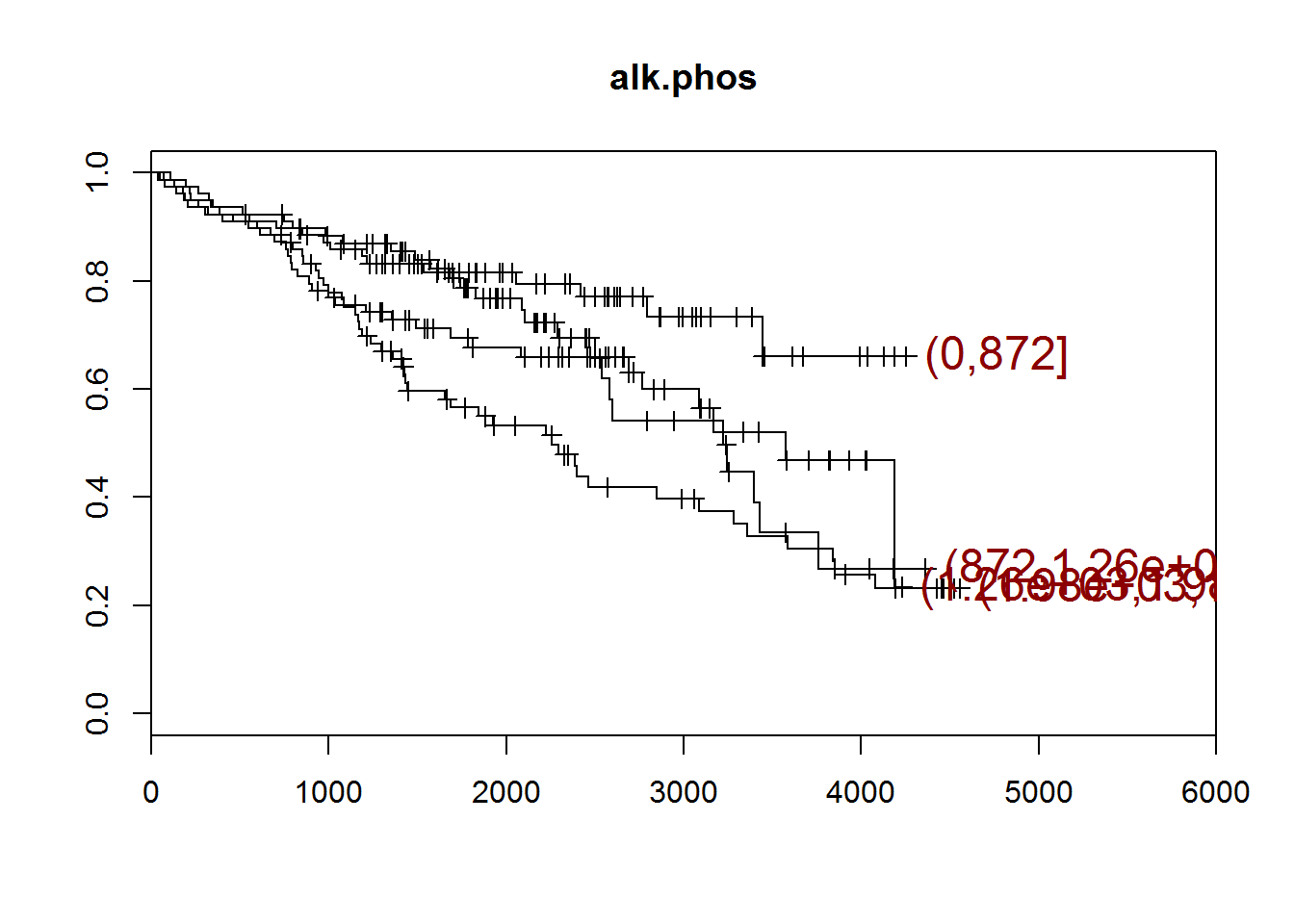
## [1] "ast"
## quartiles
## (0,80.6] (80.6,115] (115,152] (152,457]
## 79 78 79 76
## [1] "There are 0 missing values."
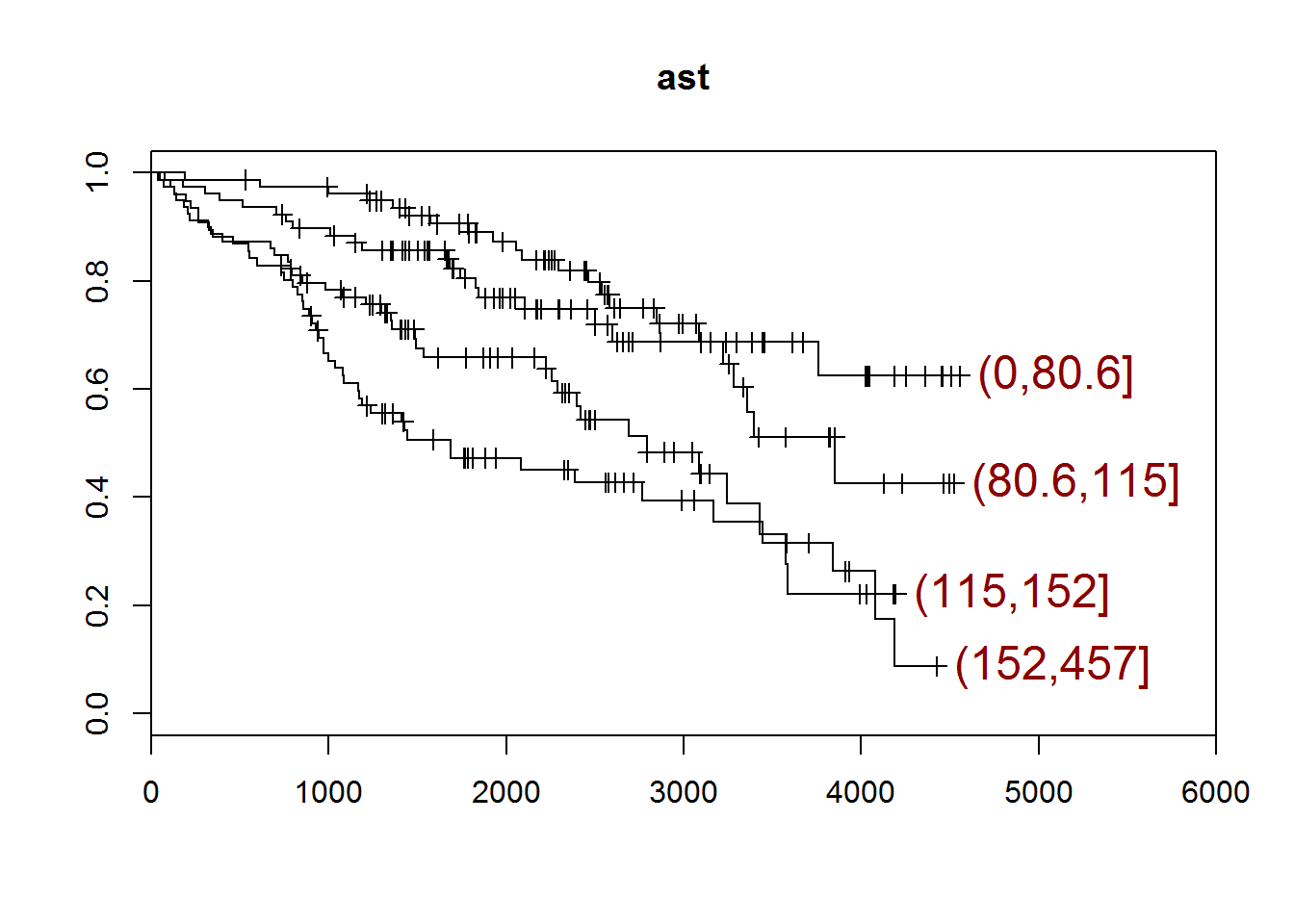
## [1] "trig"
## quartiles
## (0,84.2] (84.2,108] (108,151] (151,598]
## 71 71 70 70
## [1] "There are 30 missing values."
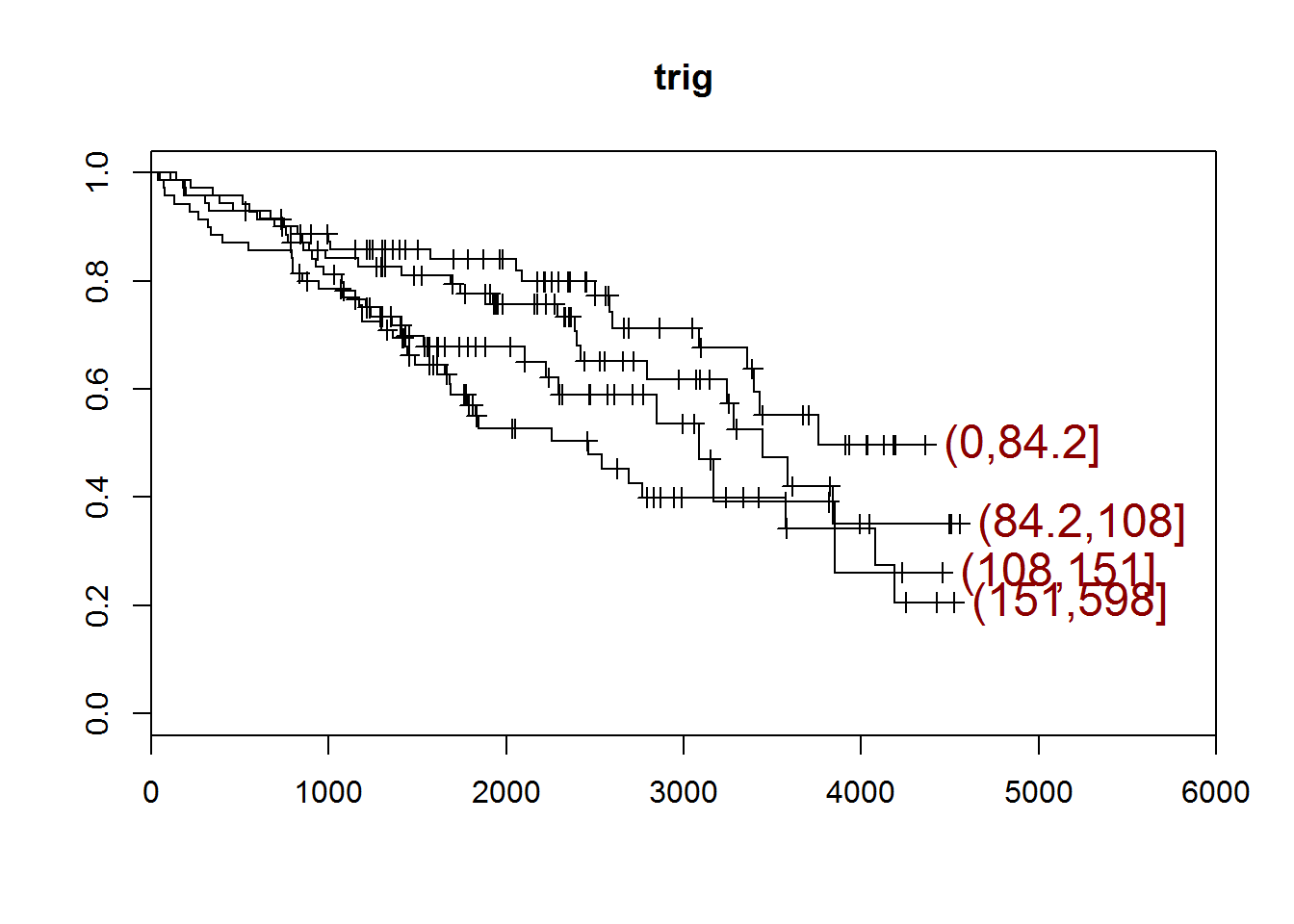
## [1] "platelet"
## quartiles
## (0,200] (200,257] (257,322] (322,563]
## 77 77 77 77
## [1] "There are 4 missing values."
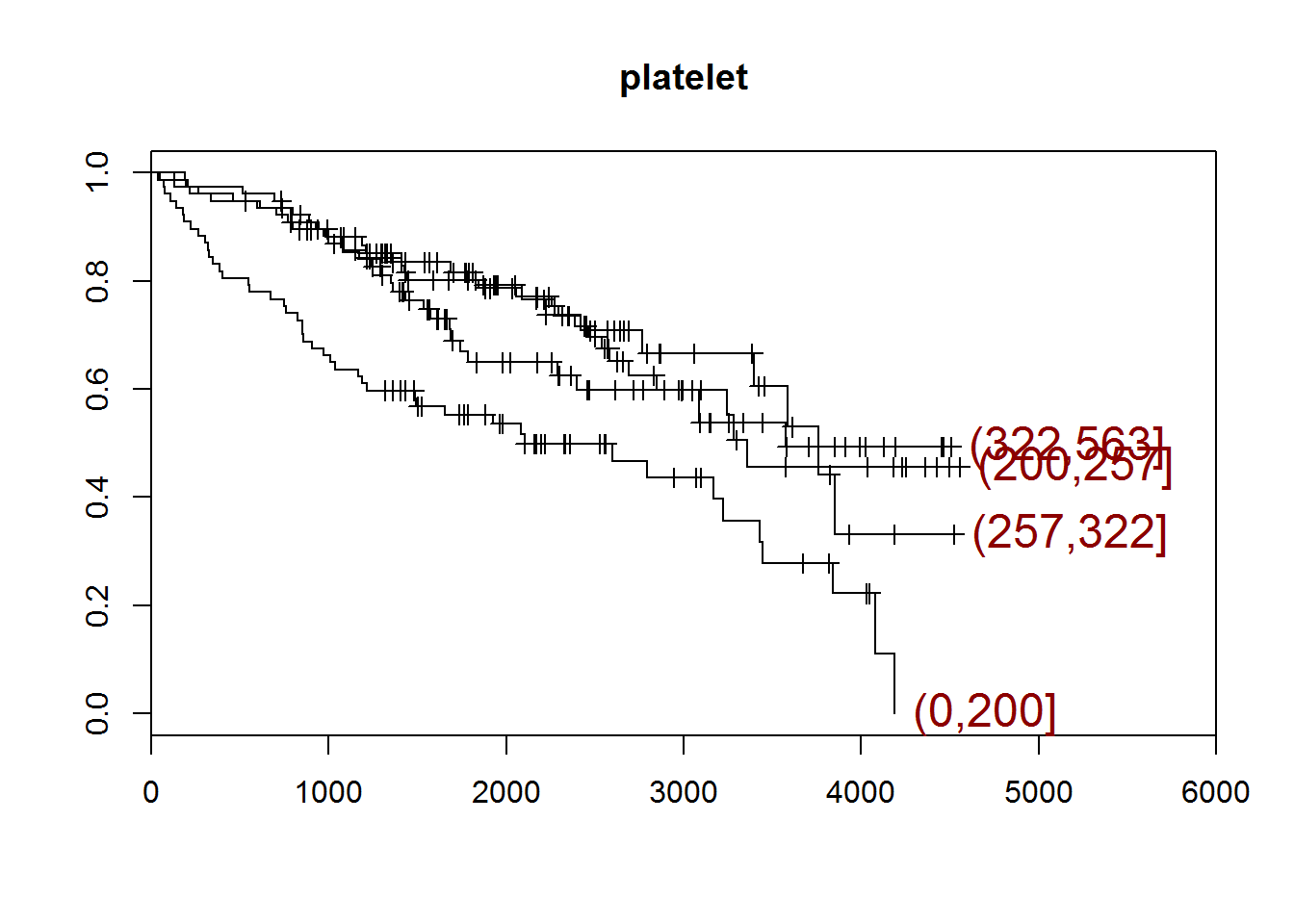
## [1] "protime"
## quartiles
## (0,10] (10,10.6] (10.6,11.1] (11.1,17.1]
## 89 85 61 77
## [1] "There are 0 missing values."
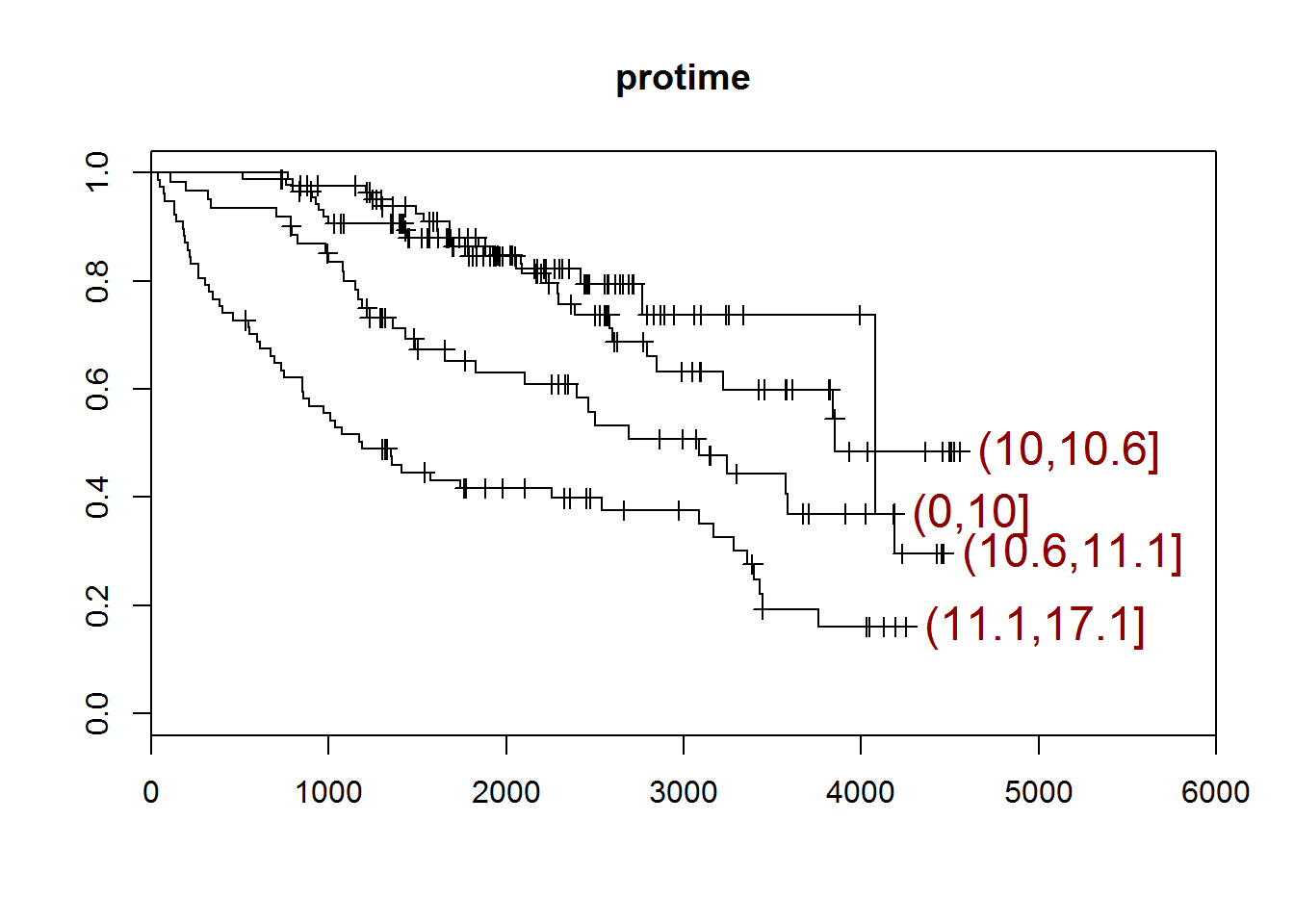
You can find an earlier version of this page on my blog.